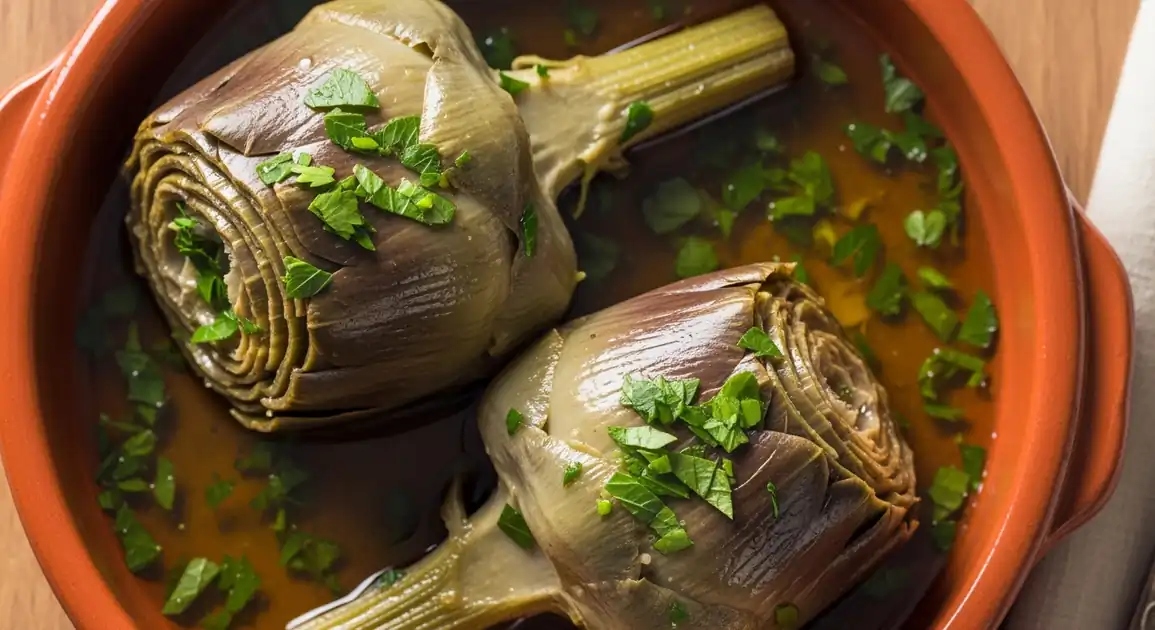Carciofi alla Romana (Roman-Style Artichokes)
Carciofi alla Romana

Description
Rome is the undisputed home of Carciofi alla Romana. During late winter and spring, this dish is ubiquitous in trattorias across the city, celebrating the prized local 'Romanesco' artichoke. Look for it on menus as 'antipasto' or 'contorno' in traditional establishments, especially in neighborhoods known for authentic cuisine like Testaccio or Trastevere.
Dietary Information
Serving information
Serving style
Served whole on a plate, sometimes with a drizzle of olive oil or its braising liquid. Usually one or two artichokes per serving.
Quick facts
Lunch: 12:30 PM - 3 PM; Dinner: 7:30 PM - 11 PM. Availability strictly tied to the Feb-May season.
Safety Tips
What to Look For
-
Served warm or room temperature (as intended)
Should be served freshly cooked and warm, or intentionally prepared for a room-temperature antipasto. Avoid suspiciously cold/hot spots suggesting poor reheating.
-
Tender texture throughout (heart and stem easily pierced with a fork)
Properly braised artichokes should be very tender. Toughness indicates undercooking.
-
Fresh, vibrant appearance (green/purple hues, not grey or overly brown)
Indicates fresh artichokes were used and cooked properly. Oxidation (greying) can occur but excessive browning or paleness is undesirable.
-
Clean restaurant environment
General cleanliness of the eatery reflects overall hygiene standards.
-
Evidence of fresh herbs
Visible parsley/mentuccia suggests authentic preparation.
What to avoid
-
Mushy or falling apart texture
Indicates the artichokes were overcooked.
-
Tough, fibrous leaves or stem
Sign of undercooking or poor quality/out-of-season artichokes.
-
Excessive oiliness or wateriness
Should be moist from braising liquid/oil, but not swimming in grease or bland watery broth.
-
Served suspiciously fast (if not explicitly an antipasto)
May indicate reheating rather than fresh braising, potentially affecting quality.
-
Artichokes offered far outside the typical season (late winter/spring)
Likely made with frozen or lower quality imported artichokes, affecting taste and authenticity.
Price information
Price range
Budget tips
- Trattorias in less touristy areas (e.g., Testaccio, parts of Prati) may offer better value.
- Consider it a shared appetizer to manage costs.
- Market prices for prepared ones (if found) would be lower.
Value indicators
- Large, tender Romanesco artichoke used.
- Authentic herbs (mentuccia noticeable).
- Properly braised – tender, not mushy or tough.
- Served at the correct temperature.
Where to Find This Dish
Testaccio
Known for its authentic Roman restaurants and food market, a great area to find seasonal dishes.
Testaccio Market, Numerous trattorias
Lunch, Dinner (during season)
Trastevere
Popular neighborhood with many trattorias, though quality can vary. Seek out more traditional spots.
Piazza Santa Maria in Trastevere, Side streets off main squares
Lunch, Dinner (during season)
Roman Ghetto
While famous for Carciofi alla Giudia (fried), some restaurants here also offer excellent Carciofi alla Romana.
Via del Portico d'Ottavia
Lunch, Dinner (during season)
Campo de' Fiori / Centro Storico
Markets sell fresh artichokes; surrounding trattorias often feature them seasonally. Can be touristy, choose carefully.
Campo de' Fiori market, Pantheon area trattorias
Lunch, Dinner (during season)
Vendor Tips
- Ask 'Sono fatti con mentuccia?' (Are they made with wild mint?) for authenticity.
- Look for restaurants displaying fresh artichokes outside during the season.
- Don't assume every restaurant does them well; check reviews or ask for recommendations focusing on seasonal Roman dishes.
How to Order
Regional Variations
-
Comparison Point: Carciofi alla Giudia
(Carciofi alla Giudia)
Found especially in the Roman Ghetto, this deep-fried version is the other famous Roman artichoke dish, offering a crispy contrast to the tender Romana style.
Cultural context
History
Artichokes have been cultivated in the Lazio region around Rome since ancient times. Carciofi alla Romana is a staple of 'cucina povera' (peasant cooking), making delicious use of the abundant local spring harvest. The Romanesco artichoke variety (also called 'cimarolo' or 'mammola'), known for its tenderness and lack of a hairy choke, is particularly suited for this whole-braised preparation. The dish reflects the Roman love for seasonal vegetables prepared simply to highlight their natural flavor, enhanced by local herbs like mentuccia.
Local significance
A quintessential Roman spring dish, deeply tied to local agriculture and culinary identity. Eating Carciofi alla Romana in season is a cherished Roman experience.
Eating customs
- The process of eating the leaves builds anticipation for the heart.
- Often debated among Romans where to find the 'best' Carciofi alla Romana.
- Paired well with Roman white wines like Frascati.